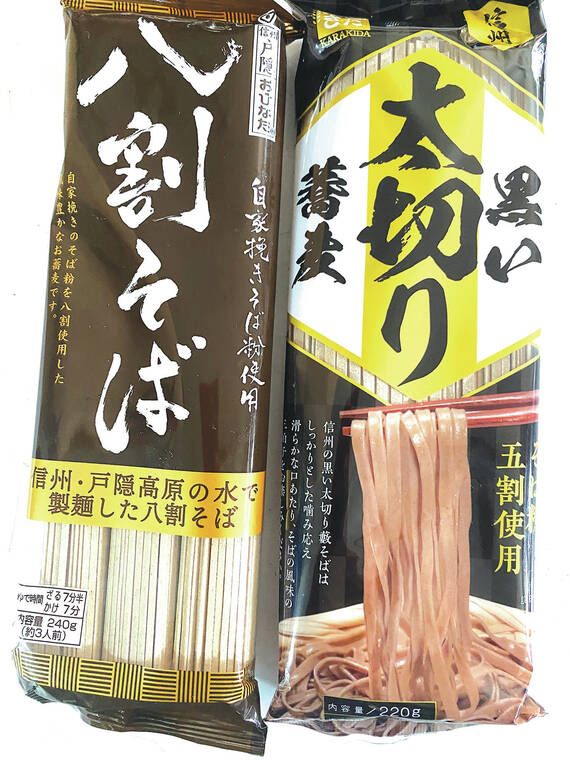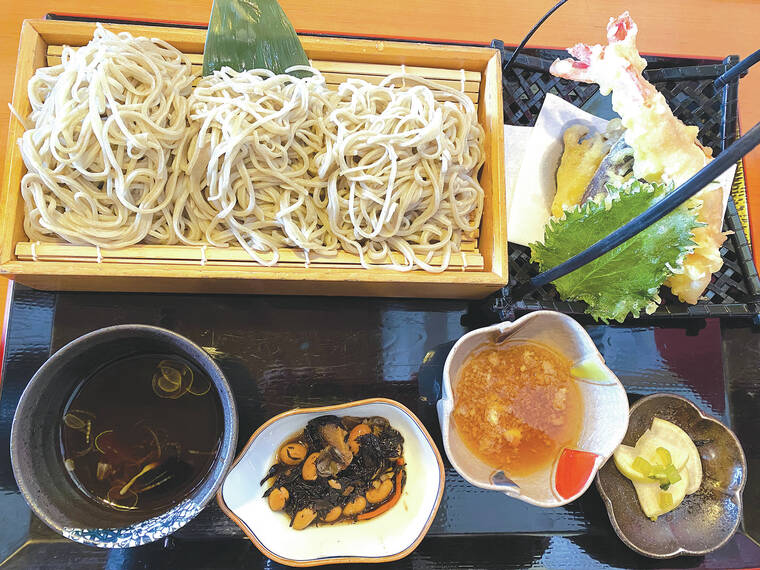Let’s Talk Food: Shinshu soba of Nagano

Dried soba from Nagano. (Audrey Wilson/Courtesy photo)

Soba in Nagano. (Audrey Wilson/Courtesy photo)
Shinshu soba is from Nagano Prefecture, Japan. Shinshu soba’s name comes from Shimano, which is the old name of Nagano Prefecture. What makes this soba so distinctive is the great temperature difference between the day and night and the well-drained mountain fields, which are suitable for the production of buckwheat. The taste of buckwheat flour is delicious because of the cold climates.
Shinshu soba is from Nagano Prefecture, Japan. Shinshu soba’s name comes from Shimano, which is the old name of Nagano Prefecture. What makes this soba so distinctive is the great temperature difference between the day and night and the well-drained mountain fields, which are suitable for the production of buckwheat. The taste of buckwheat flour is delicious because of the cold climates.
Many believe that Shinshu soba is the birthplace of buckwheat and Nagano Prefecture makes the majority of it. Only noodles with more than 40 percent buckwheat content can be called Shinshu soba.
Buckwheat is grown in agricultural areas where the growing of rice is difficult. Buckwheat is fast-growing and hardy and in the mountainous soils of Nagano, so it became an important backup crop.
Because buckwheat became such an important agricultural crop in the cold climate of the highlands, Shinshu soba became Naganos’s local dish. It is also the birthplace of soba-kiri, a soba that is cut very thinly, about the same size as somen. This type of soba is served on special occasions
Buckwheat contains many essential amino acids such as lysine, which is important for physical development. It also contains a lot of B vitamins. Vitamin B1 is an essential nutrient and the lack of this vitamin can cause loss of physical strength, irritability and loss of appetite. Vitamin B2 is also present, and is responsible for healthy skin. Buckwheat is the only cereal that contains rutin, a type of vitamin P, which has the effect of preventing the aging of blood vessels. When taken with vitamin C, they both can prevent blood vessels from becoming fragile.
Buckwheat flour has no gluten at all, so it is tricky to work with. Most professional soba makers have years of experience and special equipment. If you make the noodles with 100 percent buckwheat flour, or “ko,” it will be gluten-free, but many soba at the market have some wheat flour to make it easier to handle. If you add boiling hot water to mix with the buckwheat flour, it will gelatinize the starches and help the dough hold together.
With just a bowl, rolling pin and upper arm strength you can make fresh soba. I bought a bag of soba-ko or soba flour from a Nagano supermarket. I tried making soba noodles with buckwheat flour that I bought at the health foods store, but it did not work and I had to throw that batch away. The dough became crumbly and did not come together. If you are not able to get buckwheat flour from Japan, Anson Mills or Cold Mountain brands are recommended.
Fresh Soba Noodles
2 generous cups, or 280 grams, or 9-1/2 ounces stone-milled buckwheat flour, either from Japan or Anson Mills or Cold Mountain
1/2 generous cup (70 grams, or 2-1/2 ounce) all-purpose flour
3/4 cup (175 grams, or 6 ounces) filtered or mineral water
Buckwheat, tapioca or potato starch for rolling the soba
Combine the flours:
Weigh the two flours. Sift them through a strainer into a large mixing bowl.
Add the water to the flour:
Measure the water and pour it over the flours.
Knead until a crumbly dough is formed:
Work the flours and water together with your hands until it comes together into a rough and slightly crumbly dough. If the dough feels dry or you can still see dry flour after a few minutes of kneading, then add water a tablespoon at a time, until all the flour is integrated. Conversely, if the dough feels very wet and sticky, add all-purpose flour a tablespoon at a time until it becomes a workable dough.
Knead the dough on the counter until smooth:
Turn the dough out onto the counter. Continue kneading until it holds together easily, does not crack while kneading, and becomes smooth. You should not need to add any more flour at this point. The dough will be very dense so you will use all your strength.
Shape the dough into a disk:
Shape the dough into a pointed cone, like a mountain peak. Press straight down on the peak with the palm of your hand, squishing it into a disk about 1/2 inch thick. The bottom should be very smooth. This step helps ensure that the dough is even and in a uniform shape before rolling.
Roll out the dough:
Sprinkle the counter with a little starch and place the dough on top. Sprinkle the top of the dough and the rolling pin with starch. Begin rolling out the dough, working from the center of the dough outward in long, even strokes. Gently tap the edges of the dough with your rolling pin to shape them into straight lines as you roll, gradually shaping the dough into as close a rectangular shape as you can make it. Use more starch as needed to prevent sticking. Continue rolling the dough into a rectangle longer than it is wide and 1/16 inch to 1/8 inch thick (as thin as possible). It’s ok to move it around on the counter and flip it over as needed. Keep in mind that the vertical width of your dough will be the length of the final soba noodles.
Fold the dough:
The next step is folding the dough in order to make it easier to cut straight. Spread a generous handful of starch over half of the dough. Fold the dough in half, like closing a book. Spread starch over the entire surface of the dough and fold the top down again. You should end up with a tidy rectangular package.
Slice the soba:
Place a pastry scraper, ruler or other thin, flat utensil over the top of the folded dough. You will use this as a guide when cutting the noodles. Using your chef’s knife, begin cutting the noodles 1/16 inch to 1/8 inch thick — the same thickness as your dough. Move the pastry scraper with an even thickness. Toss the cut noodles with a little more starch to prevent sticking. Cook or freeze the soba within a few hours.
Cook the soba:
Set a strainer in your sink. Fill a bowl with cold water and ice cubes, and set near the sink. Bring a large pot of water to a boil. Salt the water generously and drop in the soba. Cool for 60 seconds, then drain through the strainer in the sink. Rinse thoroughly under cool water, lifting and gently shaking the soba until the cooking film is rinsed away, immediately dunk in a bowl of ice water. Drain and serve with dashi, soy sauce and sesame oil, or use your own soba recipe. (I like it in miso soup).
Email Audrey Wilson at audreywilson808@gmail.com.


